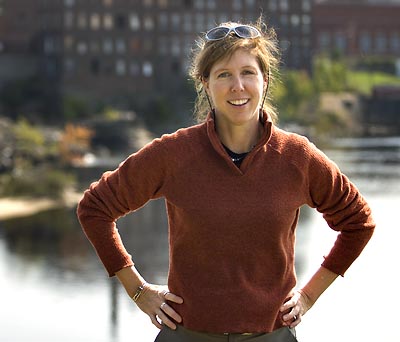
What's the Dam Point?

Lynne Lewis stands on the Auburn side of the Androscoggin River with the former Cowan Mill, in Lewiston, in the background.
Shortly after a press release announced Lynne Lewis’ scholarly article on dam removal, the Bates environmental economist learned where her academic research really hits home.
“Someone called from Augusta, Ga., wanting to talk about dam removal on the Savannah River,” Lewis recalls. “A guy on the Snake River in Idaho e-mailed me, and so did a guy from Oregon where a dam is coming out on the Sandy River.”
For people in scores of U.S. communities, Lewis’ research is news they can use. “Hundreds of small dams around the country will come up for relicensing over the next decade,” she says. “It is a contentious topic, and people who are considering dam removal want some numbers.”
The numbers that Lewis and her coauthors produced in their article show that when a small hydroelectric dam is removed — in this case, a dam on the Kennebec River in Augusta — the value of nearby homes goes up. It’s a landmark study because it’s the first such hedonic analysis, one that tries to estimate what people are willing to pay for “various attributes of housing choice, including environmental quality,” says Lewis. In this case, the question is what people will pay to be near a free-flowing river.
Looking back, Mainers living in river cities like Waterville, Augusta, or Lewiston historically would pay to live quite far from the water, which was seen as a sometimes stinky part of the cities’ industrial landscape. But in her complex examination of three Kennebec River hydropower sites, including the site of the former Edwards Dam in Augusta, Lewis found a changing reality. While property values near the river are still lower than those farther away, riverfront values have increased.
Lewis’ findings appeared in the April 2008 issue of Contemporary Economic Policy and were co-authored by Curtis Bohlen, director of the Casco Bay Estuary Partnership at USM’s Muskie School of Public Service (and former Bates faculty member), and by Sarah Wilson ’06, now a research analyst with the Washington state Department of Ecology.
“This is real pioneering work,” says David Hart, director of the Sen. George J. Mitchell Center for Environmental and Watershed Research at the University of Maine. While most people agreed on other improvements since the dam removal — the return of striped bass and Atlantic salmon and a spike in recreational use — “only in the last decade has there been any movement to understand the economic consequences of dam removal,” Hart says.
“Lynne has provided a model for how to do it. Without studies like this, we’re really flying blind.”
Lewis grew up in water-rich New England, but her interest in water management was piqued out West at the University of Colorado, where she earned a Ph.D. in economics. She studied under Charles Howe, perhaps the best-known water economist in a region where water issues are historically and notoriously politicized. Says Lewis, “Here I was in the high-plains desert asking, ‘Where’s the water?'” In 1995, her dissertation on water-sharing across state lines and how to resolve disputes received the Universities Council on Water Resources Dissertation Award.
Since returning to New England, Lewis, an associate professor of economics, has applied her knowledge and skills to the East’s wetter environment. Here, she says, “water is a very contentious topic as well, though the issues are more quality-related than quantity-related.” Maine, in particular, is a living laboratory of environmental economic issues that can test an academic’s skill at communicating new knowledge with multiple audiences, from Bates students to lay people outside the College.
“It is important to me to be working on local issues,” says Lewis. “I want to make a difference where I live, and it is important to me to convey to the public the knowledge created at an institution like Bates. And I want to be studying current issues. I couldn’t be an academic without doing something real.”
The Edwards Dam, which had blocked the lower reaches of the Kennebec River for 162 years, was the first dam in U.S. history to have its hydropower license renewal refused by the Federal Energy Regulatory Commission. “Typically when dams came up for relicensing, they would do a cost-benefit analysis, but it was superficial,” Lewis says. “It was always power versus no power and, of course, power wins.”
In the case of the Edwards, however, an alliance known as the Kennebec Coalition convinced FERC that it needed to do a better job at estimating the potential environmental, social, and economic benefits of removing the dam — from allowing migratory fish to return to the river to increasing recreational opportunities. And in 1997, FERC recommended “complete removal of the dam,” which was breached on July 1, 1999.
Lewis joined the Bates faculty in 2000, and as the years went by she became “intrigued that no one had investigated whether the predictions about the good things that would happen as a result of the dam’s removal were right.” The hedonic study, however, is just a start.
In a forthcoming issue of the Journal of the American Water Resources Association, Lewis and Jesse Lance Robbins ’06 will present survey findings that indicate that anglers are spending more money and visiting more spots on the Kennebec. Meanwhile, she and her students are surveying Lewiston-Auburn residents about the Androscoggin River’s role in their decision to purchase property.
It’s all groundbreaking work, says Nick Bennett, watershed project director for the Natural Resources Council of Maine. The NRCM is a member of the Penobscot River Restoration Trust, which has purchased three dams from an energy company with the aim of demolishing two and constructing a fish bypass on the third.
“Maine law requires dam projects to have economic benefits, but mostly we’ve had to make that determination qualitatively,” Bennett says. “All of us who care about these things believe fishing has gotten better on the Kennebec, but Lynne is getting the numbers that give rigor to those qualitative judgments. That’s pretty cool.”
By Virginia Wright, photograph by Phyllis Graber Jensen
Freelance writer Virginia Wright wrote about the Harward Center’s collaboration with Museum L-A in the Summer issue of Bates Magazine.




